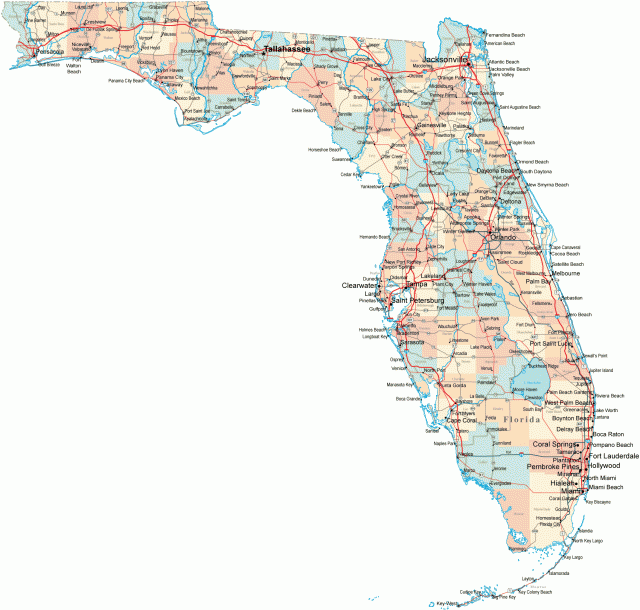The State of Florida
AT A GLANCE
Name: Spanish explorer Ponce de Leon named Florida when he landed there on Easter Sunday in 1513. He called the place Pascua Florida, which means “flowery Easter” in Spanish.
Nickname: Sunshine State
Capital: Tallahassee
Size: 59,928 sq. mi.
Population: 20,271,272 (2015 est)
Statehood: Florida became the 27th state on March 3, 1845.
Electoral votes: 27 (2016)
U.S. Representatives: 23 (until 2016)
State tree: sabal palmetto
State flower: orange blossom
State marine mammal: manatee
Highest point: Britton Hill, 345 ft.

THE PLACE
Florida is a long peninsula surrounded by water on three sides. To the west is the Gulf of Mexico; to the east is the Atlantic Ocean. Only Alaska has a longer coastline than Florida.
The northwestern part of the state is called the Panhandle and lies along the Gulf of Mexico. The southernmost tip of Florida is less than 100 miles from the island nation of Cuba. The Everglades, a region of swamps and wetlands, cover most of southern Florida.
Most of Florida's terrain north of the Everglades is level or rolling. More than half the state is forested. Lake Okeechobee is the largest lake in Florida and covers 680 square miles (1,1768 square km). It is the second-largest natural freshwater lake in the United States. many other small lakes are scattered throughout central Florida. Florida is also famous for springs from which clear water flows.
Floroda's climate is subtropical except in the south, where it is tropical. Summers are hot, humid, and sunny, while winters are generally mild. This climate is excellent for many types of agriculture.
Limestone is the state's most plentiful mineral, but Florida also has the largest deposits of phosphate in the United States. Mineral sands are also important to Florida's economy.
Facts and Firsts
- Florida is the southernmost of the continental United States.
- One of only two naturally round lakes in the world is in DeFuniak Springs.
- Fort Lauderdale's 185 miles of local waterways helped earn it the nickname the Venice of America.
- The Florida Keys, a series of islands off the coast, extend more than 150 miles from Florida's southernmost tip.
- Every year, more people go to Orlando than to any other city in the United States to visit the many amusement parks located there.
- All American spaceflights are launched from Cape Canaveral, including the Apollo 11 flight that carried astronauts to the moon for the first time.
- Clearwater has the highest per capita (per person) rate of lightning strikes of any place in the United States.
- Gatorade, a popular sport drink, was invented in Florida and named after the University of Florida's mascot, the Gators.
- In 1944, Benjamin Green, a pharmacist from Miami Beach, invented suntan lotion by cooking cocoa butter.
THE PAST
Ponce de Leon claimed the region for Spain in 1513 during his search for the mythical Fountain of Youth. In 1565, Pedro Menendez de Aviles founded St. Augustine, the site of the first permanent European settlement in North America. Although the Spanish settled and built missions in the northern area of what later became the state of Florida, portions of the region fell under British control around 1763.
The territory did not become part of the United States until 1821, when Spain sold it to the United States. Florida was the site of fighting between settlers and Native Americans. This fighting, known as the Seminole Wars, ended in 1842. The United States established control of the region, and Florida became a state in 1845.
When the Civil War began, Florida seceded from the United States with the rest of the South. It was readmitted to the Union in 1868.
In the late 19th and early 20th centuries, areas of swampland were drained to expose the fertile soil beneath for farming. This new land stimulated the first of several population booms in southern Florida when people came to the area with hopes of getting rich by farming or by buying and selling real estate. Florida quickly became prime agricultural land, but after great fires in 1939, studies of the Everglades concluded that most of the southern part was unfit for cultivation.
As early as the 1870s, residents from northern states traveled south to spend the winter months in Florida to enjoy the state's natural beauty and mild climate. Steamboat tours on Florida's winding rivers were a popular attraction for these visitors. One hundred years later, in 1971, Florida tourism got a big boost when Walt Disney World opened in Orlando.
THE PRESENT
Florida's biggest industry is tourism. Some of the popular attractions located in Florida include Walt Disney World, Sea World, Everglades National Park, and Kennedy Space Center. The large theme parks in the Orlando area, as well as other attractions, annually bring more than 40 million visitors from the United States and countries around the world.
Florida's warm temperatures and sandy beaches also contribute to its popularity with vacationers. Florida's service industries provide food, communication, utilities, medical care, entertainment, housing, and transportation to tourists and the state's growing population. These service industries form the foundation of Florida's economy.
The warm climate and long growing season allow farmers to grow fruits and vegetables, especially citrus fruits, yearround. Florida grows almost two-thirds of the nation's oranges and three-fourths of its grapefruit.
Many other industries help round out Florida's diverse economy. Banking and business services are quickly growing industries. Many Floridians raise cattle. Florida also manufactures aerospace and aircraft equipment and electrical equipment, such as telephones and X-ray machines.
Born in Florida
- Julian “Cannonball” Adderley, jazz saxophonist
- Fernando Bujones, ballet dancer, choreographer
- Faye Dunaway, actress
- Zora Neal Hurston, writer
- Jim Morrison, singer
- Sidney Poitier, actor
- A. Philip Randolph, labor leader
- Joseph W. Stilwell, army general